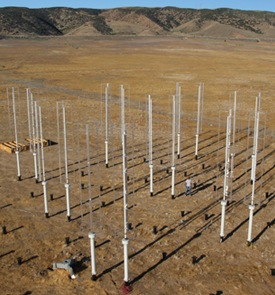Caltech research: clusters of small turbines outperform sprawling wind farms
Science, Wind turbines Add comments
The first field results from a Caltech research team led by John Dabiri have been published, and they suggest that Dabiri’s new approach to wind generation may be just what rural communities have been hoping for: the ability to proceed with widespread wind energy development without changing the character of local landscapes and soundscapes.
Dabiri’s team is looking at wind energy efficiency from an entirely new perspective: rather than designing individual turbines to capture as much of the wind energy passing through their blades as possible, they’re looking to capture as much of the wind energy in the projects footprint as possible. Instead of the 300-400 foot 3-armed turbines we’re used to, the Caltech team is optimizing a tightly-packed array of 30-foot spinning vertical tubes (vertical-axis turbines) that look more like egg beaters or old-fashioned lawnmowers turned on end. Inspired by fish schooling, the turbines use the air flow from one another to optimize energy capture and efficiency; by contrast, giant horizontal-axis turbines (the standard design we’re familiar with) need to be very far apart so that their turbulent wakes don’t interfere with each other.

In the first field season, last summer, a tiny test plot of just six turbines was arrayed in various configurations, so the team could find what works best. This summer, 24 turbines are being used in the second year of field tests. Last summer’s results, while clearly preliminary, are exciting: the array produced 21-47 watts of electricity per square meter. That may not sound like much, but a bit of high school math reveals that if this design scales up (even assuming just 30 watts/meter), a 1km by 1km plot of land (a bit over a half mile on each side) would produce as much electricity as one of today’s wind farms with two hundred 1.5MW 300-foot towers spread over many square miles. Put another way, a patch of land 200 feet on each side would produce the same amount of electricity as a single 1.5MW turbine, which generally needs a safety buffer of at least 500 feet on all sides. The downsides of the new approach are that the productive wind installation would use all of the land in its footprint, unlike current wind farms in which the distantly-spaced turbines leave plenty of room for grazing or planting. Horizontal axis turbines can also suffer more stress under high winds, though undoubtedly new materials and engineering approaches will address this issue.
There’s clearly a long way to go to bring this new design to utility-scale wind production, but of all the new approaches to wind energy, this is one of the most promising!
For more on Dabiri’s work, see this Caltech press release and visit Dabiri’s lab’s web page, which includes a video and links to a Powerpoint and the recently published paper.
